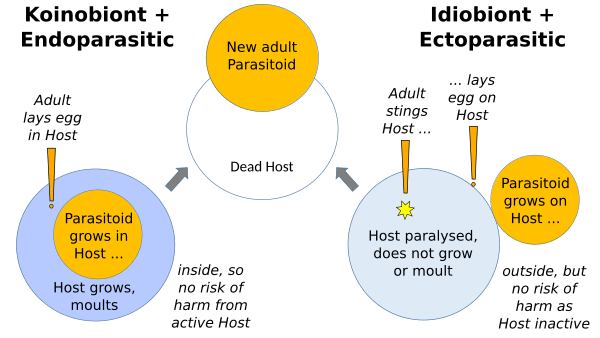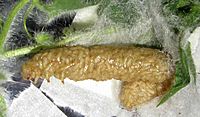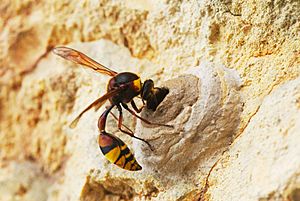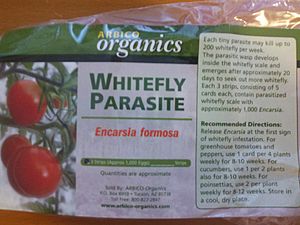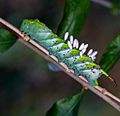Parasitoid wasp facts for kids
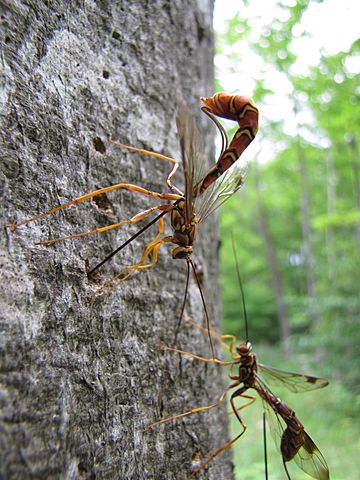
Parasitoid wasps are a large group of wasps. They are special because they lay their eggs on or inside other arthropods. These arthropods are called "hosts." The wasp larvae then eat the host, which eventually kills it. Different wasp species attack different kinds of insects. Most often, they target moths and butterflies, but some choose beetles, flies, or bugs. Spider wasps, for example, only attack spiders.
Parasitoid wasps attack hosts at different stages of life. This could be eggs, larvae (like caterpillars), pupae, or even adult insects. They use two main ways to live as parasitoids. Some are endoparasitic, meaning they grow inside the host. They are also koinobiont, which means they let the host keep living, eating, and growing. Others are ectoparasitic, meaning they grow outside the host. These are idiobiont, which means they paralyze the host right away. Some endoparasitic wasps even work with special polydnaviruses. These viruses help the wasp by stopping the host's body from fighting off the wasp.
Parasitoidism (this way of life) started only once in the wasp family tree. This happened a very long time ago, during the Permian period. But some wasps, like ants and bees, later stopped being parasitoids. Because of this, the wasp family has many groups of parasitoids mixed with groups that are not. Some parasitoid wasp groups are huge. For example, there might be 500,000 species of chalcid wasps, 100,000 species of Ichneumonidae, and up to 50,000 species of braconid wasps. Host insects have developed many ways to defend themselves. They might hide, wriggle, or use camouflage. Many parasitoid wasps are helpful to humans. They naturally help control insect pests in farms. Some are even used in pest control by farmers. This started in the 1920s with a wasp called Encarsia formosa. It was used to control whiteflies in greenhouses. The idea of parasitoid wasps even influenced Charles Darwin's thinking.
Contents
How Wasps Attack Their Hosts
Parasitoid wasps come in many sizes. Some are among the smallest insects, while others are about an inch long. Most female wasps have a long, sharp tube called an ovipositor at the end of their body. This tube is used to lay eggs. It usually does not have venom glands and is almost never used for stinging like a bee's stinger.
Wasps can be grouped by how they live. They can live inside their host's body as endoparasitoids. Or they can feed on the host from the outside as ectoparasitoids. Both ways are found in parasitoid wasps. Wasps are also grouped by what they do to their hosts. Idiobionts stop the host from growing any more after they first attack it. Koinobionts let the host keep growing while the wasp feeds on it. Both types are found in parasitoid wasps. Most ectoparasitoid wasps are idiobiont. This is because the host could hurt or shake off the wasp if it was allowed to move. Most endoparasitoid wasps are koinobionts. This lets them use a host that keeps getting bigger, giving them more food. It also helps the host avoid predators.
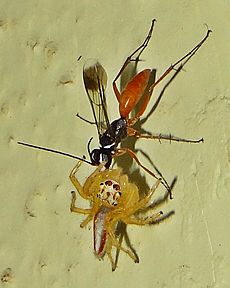
Many parasitoid wasps use moth and butterfly larvae (caterpillars) as hosts. But some groups attack different life stages of almost all other insect types. These include beetles, flies, bugs, and even other wasps. Some wasps attack other arthropods, not just insects. For example, spider wasps specialize in catching spiders. Spiders are fast and dangerous prey, often as big as the wasp. But the spider wasp is quicker. It quickly stings its prey to make it unable to move.
Female wasps usually lay their eggs inside the host's body or eggs. Some also inject a mix of special liquids. These liquids can paralyze the host or protect the wasp egg from the host's immune system. This mix can include polydnaviruses, special proteins, and venom. If a polydnavirus is injected, it infects the host's cells. This causes problems for the host, which helps the wasp.
The size of the host is important for the wasp's growth. The host is the wasp's only food until it becomes an adult. Small hosts often lead to smaller wasps. Some wasp species lay female eggs in larger hosts and male eggs in smaller hosts. This is because smaller body size affects male wasps less. Some parasitoid wasps mark the host with special chemicals. This shows that an egg has been laid there. This can stop other wasps from laying eggs there. It also tells the wasp itself that no more eggs are needed in that host. This helps make sure the young wasps have enough food and survive better.
The Wasp Life Cycle
On or inside the host, the parasitoid egg hatches into one or more larvae. Sometimes, one egg can split into many larvae. This is called polyembryony. Endoparasitoid eggs can take in fluids from the host's body. They can grow much bigger than when they were first laid before hatching. The first larva stage is often very active. It might have strong jaws or other parts to fight with other wasp larvae. Later larva stages usually look more like grubs.
Parasitoid larvae have a special digestive system. It has no rear opening. This stops their waste from harming the host. The larva eats the host's tissues until it is ready to become a pupa. By this time, the host is usually dead or almost dead. The larva then gets rid of its stored waste. This happens as it changes into a prepupa. Depending on the species, the wasp might then eat its way out of the host. Or it might stay inside the host's empty skin. In either case, it usually spins a cocoon and becomes a pupa.
As adults, parasitoid wasps mostly drink nectar from flowers. Females of some species also drink blood-like fluid from hosts. This gives them extra nutrients to make eggs.

Wasp Teamwork with Viruses
Polydnaviruses are special insect viruses. They have a helpful relationship with some parasitic wasps. The polydnavirus grows inside the egg-laying tubes of an adult female wasp. The wasp benefits from this teamwork. The virus protects the wasp larvae inside the host. It does this in two ways. First, it weakens the host's immune system. Second, it changes the host's cells to be more helpful to the wasp. This relationship is very important for these wasps. All wasps of these species are infected with the viruses. The virus has become part of the wasp's own genes and is passed down to its young.
How Hosts Defend Themselves
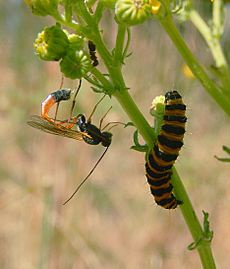
The insects that wasps attack have developed many ways to protect themselves. Many hosts try to hide from wasps in places that are hard to reach. They might also get rid of their waste and avoid plants they have chewed on. Both of these can tell wasps that a host is nearby. The egg shells and outer skin of potential hosts can become thicker. This makes it harder for the wasp to lay eggs.
Hosts may try to escape when a female wasp comes to lay an egg. They might drop off the plant they are on. They could twist and thrash around to try to shake off or kill the wasp. Some even spit up liquid onto the wasp to trap it. Wriggling can sometimes make the wasp miss laying the egg on the host. Instead, it might lay it nearby. Wriggling pupae can make the wasp lose its grip on their smooth, hard bodies. Or the wasp might get caught in silk threads. Some caterpillars even bite female wasps that come near them. Some insects release poisonous chemicals that kill or scare away the wasp. Ants that live with caterpillars or aphids might protect them from wasp attacks.
Even parasitoid wasps can be attacked by other wasps! These are called hyperparasitoid wasps. Some parasitoid wasps change the behavior of their infected host. They make the host build a silk web around the wasp pupae after they leave its body. This protects the young wasps from hyperparasitoids.
Hosts can kill endoparasitoids by covering the egg or larva with their blood cells. This is called encapsulation. In aphids, a special type of bacteria inside them can make the aphid immune to wasps. This bacteria kills many of the wasp eggs. Wasps need to survive the host's immune system. So, some wasps lay more eggs in aphids that have this bacteria. This increases the chance that at least one egg will hatch and parasitize the aphid.
Some caterpillars eat plants that are harmful to both themselves and the parasite. This helps them get rid of the parasite. Drosophila melanogaster larvae (fruit fly larvae) also "self-medicate" with alcohol to fight off wasps. Female D. melanogaster flies lay their eggs in food with alcohol if they sense wasps nearby. The alcohol protects them from the wasps. But it also slows down their own growth.
Wasp Evolution and Groups
Scientists believe that parasitoidism started only once in the wasp family. This happened about 247 million years ago. All parasitoid wasps come from this one group, except for the Orussoidea wasps. These wasps are parasitic but do not have the special "wasp waist." The special wasp waist appeared later. It helped wasps become more diverse. This is because it made the egg-laying tube easier to move. This allowed wasps to lay eggs in more places.
The wasp family tree shows where parasitoid groups fit in. The groups in bold are mostly parasitoids. The groups in italics are ones that used to be parasitoids but are not anymore. The numbers in parentheses show how many species are estimated to be in these groups. Some of these numbers are very large, like 500,000 for chalcid wasps. Not all species in these groups are parasitoids. For example, some Cynipoidea wasps eat plants.
| Hymenoptera |
|
|||||||||||||||||||||||||||||||||||||||||||||||||||||||||||||||||||||||||||||||||||||||||||||||||||||||||||||||
Wasp Families
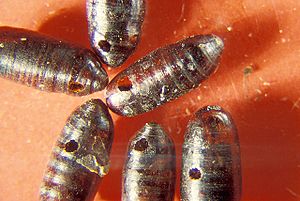
The term "parasitoid wasps" does not include all wasps. For example, ants, bees, and non-parasitic wasps like the Vespidae are not included. Also, some members of mostly parasitoid families are not parasitic themselves. Below are some wasp families where most members live as parasitoids.
|
|
|
How Wasps Help Humans
Natural Pest Control
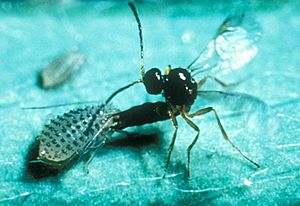
Parasitoid wasps are very helpful because they naturally control many harmful insects. They are widely used in biological pest control. This means using natural enemies to fight pests instead of chemicals. The most important groups for this are ichneumonid wasps, which mostly attack caterpillars. Braconid wasps attack caterpillars and many other insects, including greenflies. Chalcid wasps parasitize the eggs and larvae of greenflies, whiteflies, cabbage caterpillars, and scale insects.
One of the first parasitoid wasps used in farming was Encarsia formosa. This wasp is an endoparasitic chalcid. It has been used to control whiteflies in greenhouses since the 1920s. Its use almost stopped in the 1940s when chemical pesticides became popular. But since the 1970s, its use has grown again in Europe and Russia. In some countries, like New Zealand, it is the main way to control greenhouse whiteflies. This is especially true for crops like tomato, which are hard for other predators to live on.
For commercial use, there are two ways to raise these wasps. One is for short-term, daily high production. The other is for long-term, year-round lower production. This allows for 4 to 1000 million female wasps per week. This helps meet the demand for different crops.
Wasps in Culture
Parasitoid wasps even affected Charles Darwin's ideas. In a letter from 1860, Darwin wrote that he could not believe a kind and all-powerful God would create parasitic wasps. He found it hard to imagine a God who would want them to feed inside living caterpillars. The scientist Donald Prothero noted that people in the Victorian era, including Darwin, were shocked by this cruelty in nature. This was especially true for the Ichneumonidae wasps.
Images for kids
See also
 In Spanish: Parasitica para niños
In Spanish: Parasitica para niños


